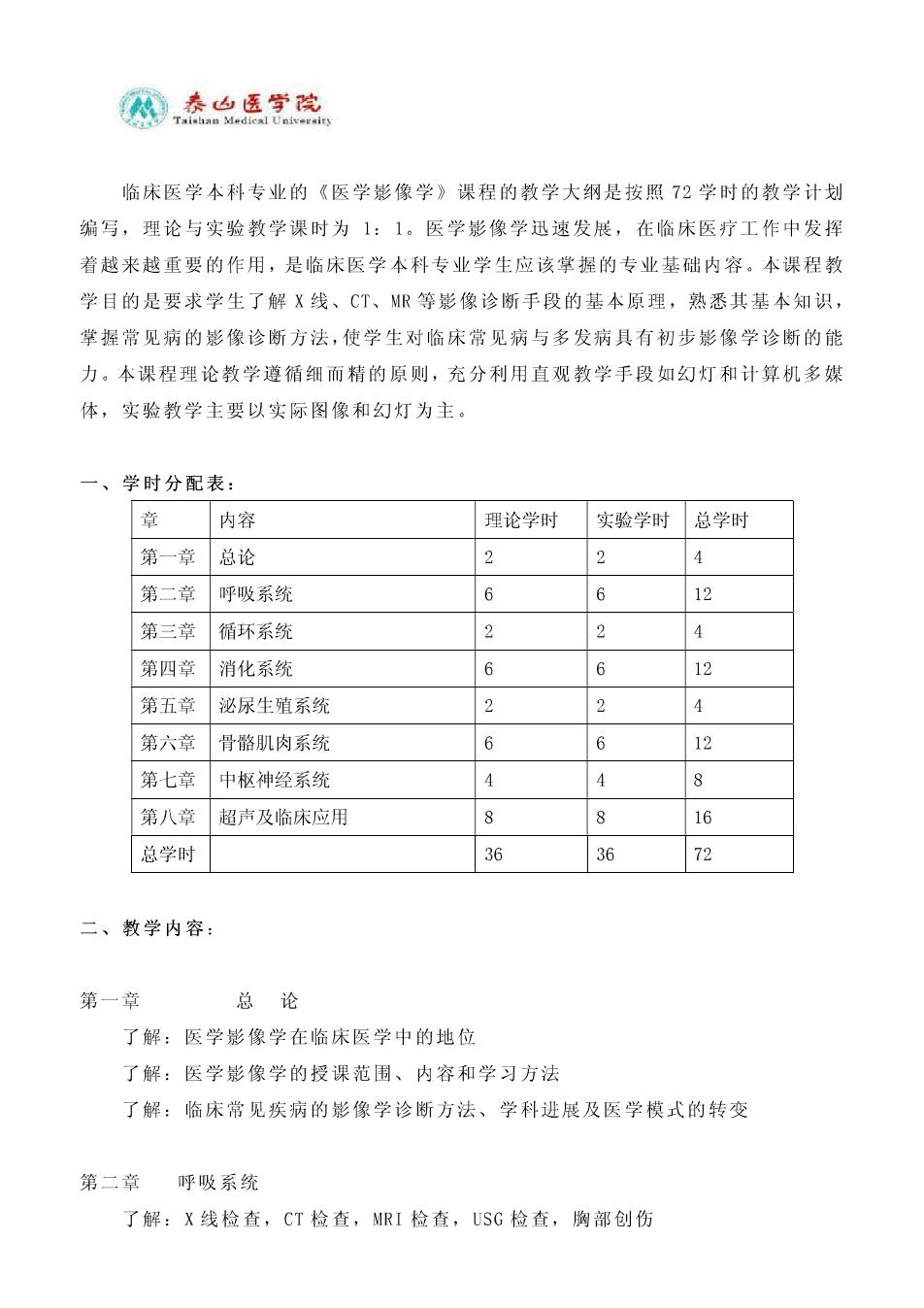
从泰白医学院 临床医学本科专业的《医学影像学》课程的教学大纲是按照72学时的教学计划 编写,理论与实验教学课时为1:1。医学影像学迅速发展,在临床医疗工作中发挥 者越来越重要的作用,是临床医学本科专业学生应该掌握的专业基础内容。本课程教 学目的是要求学生了解X线、CT、R等影像诊断手段的基本原理,熟悉其基本知识, 掌握常见病的影像诊断方法,使学生对临床常见病与多发病具有初步影像学诊断的能 力。本课程理论教学遵循细而精的原则,充分利用直观教学手段如幻灯和计算机多媒 体,实验教学主要以实际图像和幻灯为主。 一、学时分配表 章 内容 理论学时 实验学时总学时 第一章总论 2 2 4 第二章呼吸系统 6 12 第三章循环系统 2 4 第四章消化系统 6 6 12 第五章泌尿生殖系统 2 2 4 第六章骨骼肌肉系统 6 6 第七章中枢神经系统 4 8 第八章超声及临床应用 8 8 16 总学时 6 二、教学内容 第一章 总论 了解:医学影像学在临床医学中的地位 了解:医学影像学的授课范围、内容和学习方法 了解:临床常见疾病的影像学诊断方法、学科进展及医学模式的转变 第二章呼吸系统 了解:X线检查,CT检查,MRI检查,USG检查,胸部创伤
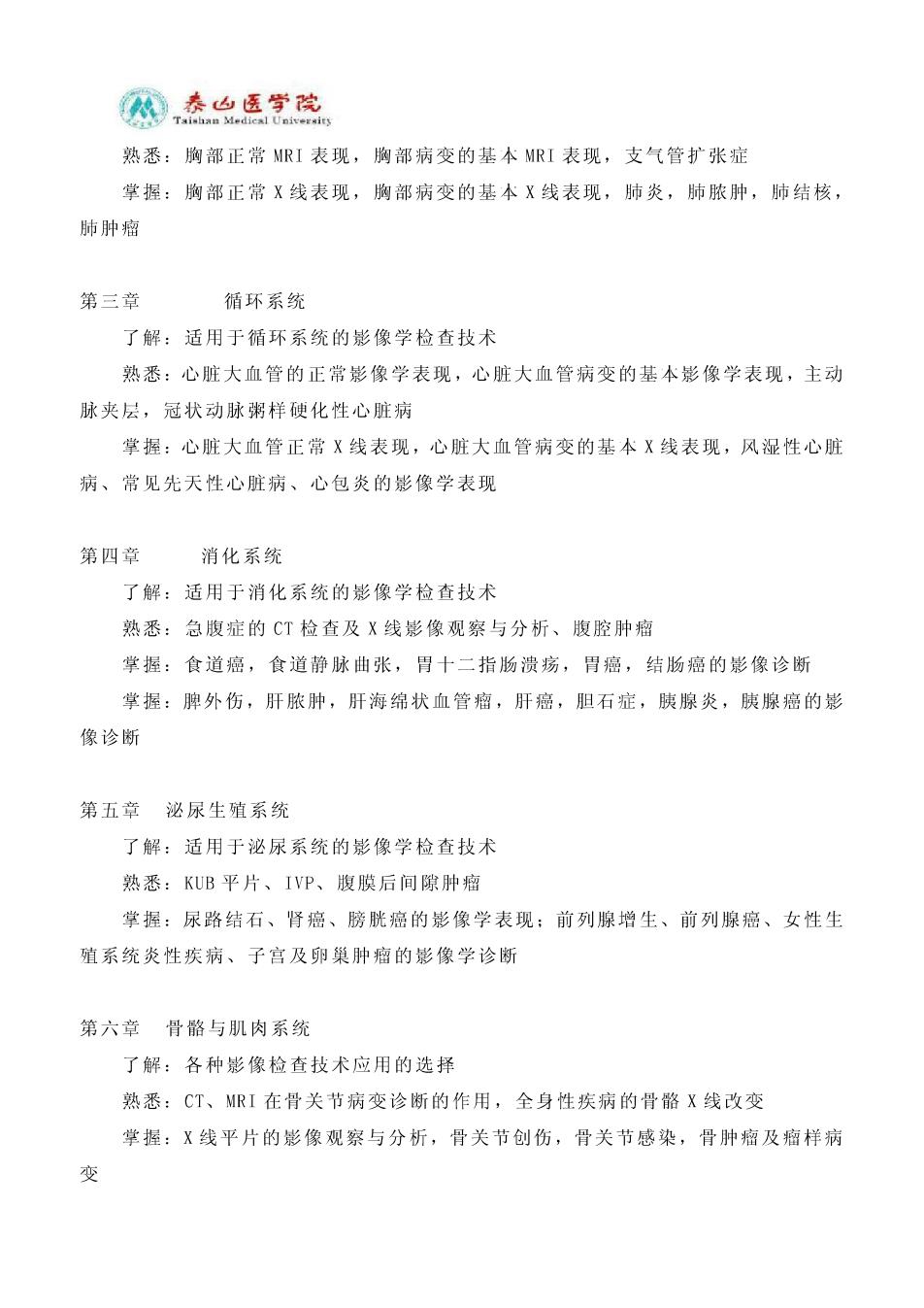
从泰医学院 熟悉:胸部正常MRI表现,胸部病变的基本MRI表现,支气管扩张症 掌握:胸部正常X线表现,胸部病变的基本X线表现,肺炎,肺脓肿,肺结核, 肺肿瘤 第三章 循环系统 了解:适用于循环系统的影像学检查技术 熟悉:心脏大血管的正常影像学表现,心脏大血管病变的基本影像学表现,主动 脉夹层,冠状动脉粥样硬化性心脏病 掌握:心脏大血管正常X线表现,心脏大血管病变的基本X线表现,风湿性心脏 病、常见先天性心脏病、心包炎的影像学表现 第四章消化系统 了解:适用于消化系统的影像学检查技术 熟悉:急腹症的CT检查及X线蟛像观察与分析、腹腔肿瘤 掌握:食道癌,食道静脉曲张,胃十二指肠溃疡,胃癌,结胸癌的影像诊断 掌握:脾外伤,肝脓肿,肝海绵状血管瘤,肝癌,胆石症,胰腺炎,胰腺癌的影 像诊断 第五章泌尿生殖系统 了解:适用于泌尿系统的影像学检查技术 熟悉:KUB平片、IVP、腹膜后间隙肿瘤 掌握:尿路结石、肾癌、膀胱癌的影像学表现:前列腺增生、前列腺癌、女性生 殖系统炎性疾病、子宫及卵巢肿瘤的影像学诊断 第六章骨骼与肌肉系统 了解:各种影像检查技术应用的选择 熟悉:CT、MRI在骨关节病变诊断的作用,全身性疾病的骨骼X线改变 掌握:X线平片的影像观察与分析,骨关节创伤,骨关节感染,骨肿瘤及瘤样病 变
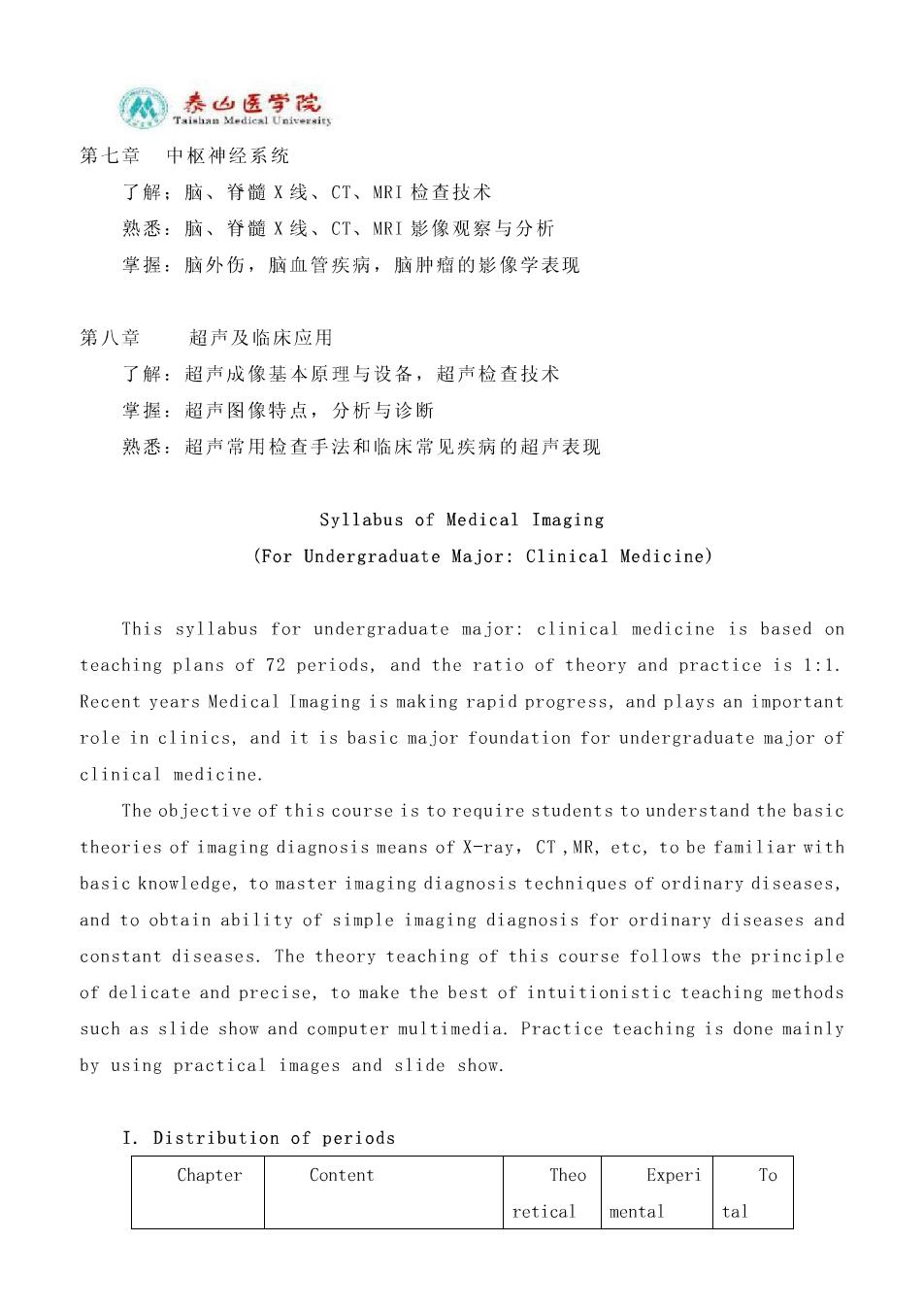
从泰山医岂院 第七章中枢神经系统 了解:脑、脊髓X线、CT、MRI检查技术 熟悉:脑、脊髓X线、CT、MRI影像观察与分析 掌握:脑外伤,脑血管疾病,脑肿瘤的影像学表现 第八章超声及临床应用 了解:超声成像基本原理与设备,超声检查技术 掌握:超声图像特点,分析与诊断 熟悉:超声常用检查手法和临床常见疾病的超声表现 Syllabus of Medical Imaging (For Undergraduate Major:Clinical Medicine) This syllabus for undergraduate major:clinical medicine is based on teaching plans of 72 periods,and the ratio of theory and practice is 1:1. Recent years Medical Imaging is making rapid progress,and plays an important role in clinics,and it is basic major foundation for undergraduate major of clinical medicine. The objective of this course is to require students to understand the basic theories of imaging diagnosis means of X-ray,CT,MR,etc,to be familiar with basic knowledge,to master imaging diagnosis techniques of ordinary diseases, and to obtain ability of simple imaging diagnosis for ordinary diseases and constant diseases.The theory teaching of this course follows the principle of delicate and precise,to make the best of intuitionistic teaching methods such as slide show and computer multimedia.Practice teaching is done mainly by using practical images and slide show. I.Distribution of periods Chapter Content Theo Experi To retical mental tal
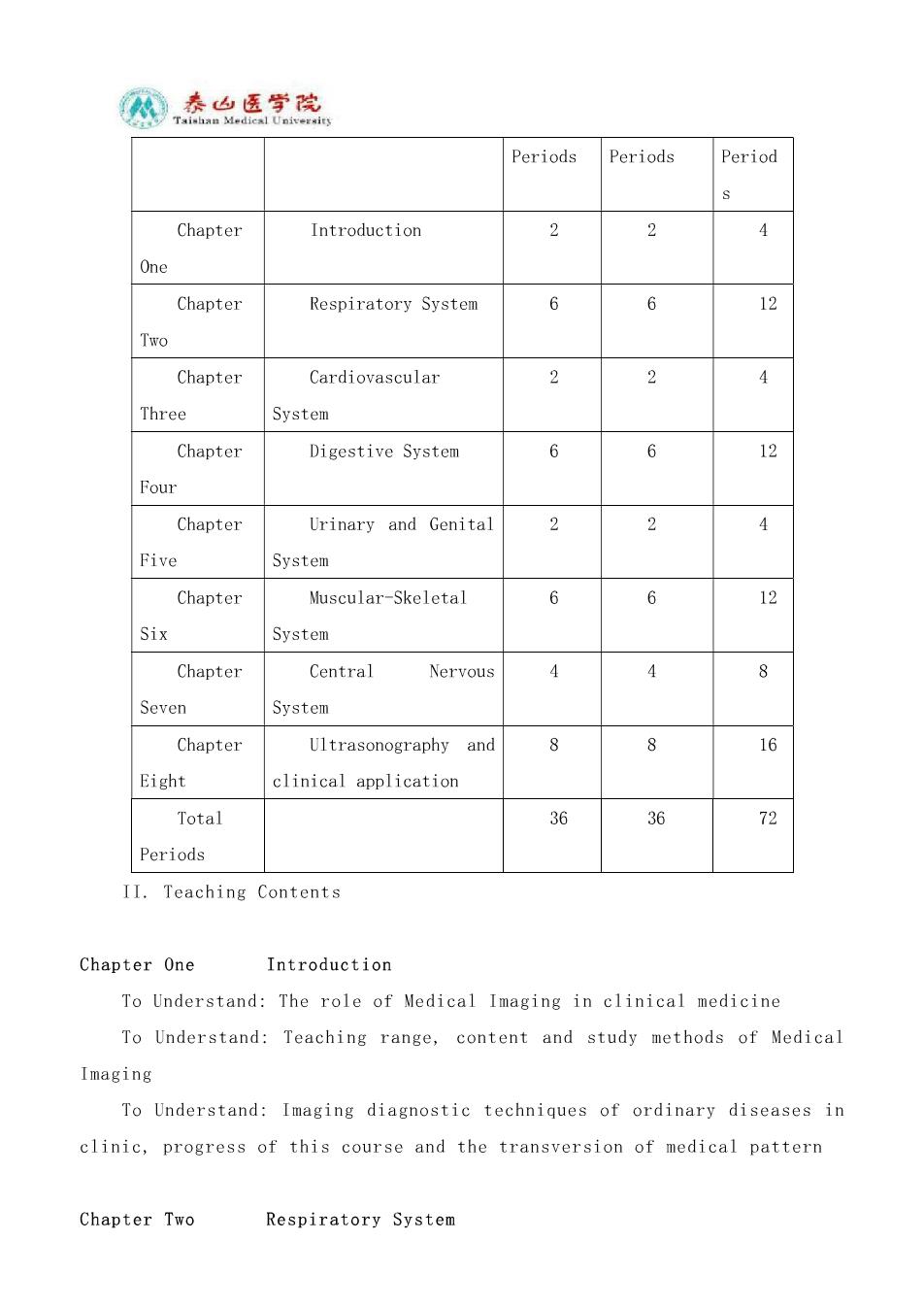
从泰医学院 Periods Periods Period Chapter Introduction 2 One Chapter Respiratory System 6 6 2 Two Chapter Cardiovascular 2 2 4 Three System Chapter Digestive System 6 6 12 Four Chapter Urinary and Genital 2 2 4 Five System Chapter Muscular-Skeletal 6 Six System Chapter Central Nervous 4 8 Seven System Chapter Ultrasonography and 8 16 Eight clinical application Total 36 36 72 Periods II.Teaching Contents Chapter One Introduction To Understand:The role of Medical Imaging in clinical medicine To Understand:Teaching range,content and study methods of Medical Imaging To Understand:Imaging diagnostic techniques of ordinary diseases in clinic,progress of this course and the transversion of medical pattern Chapter Two Respiratory System
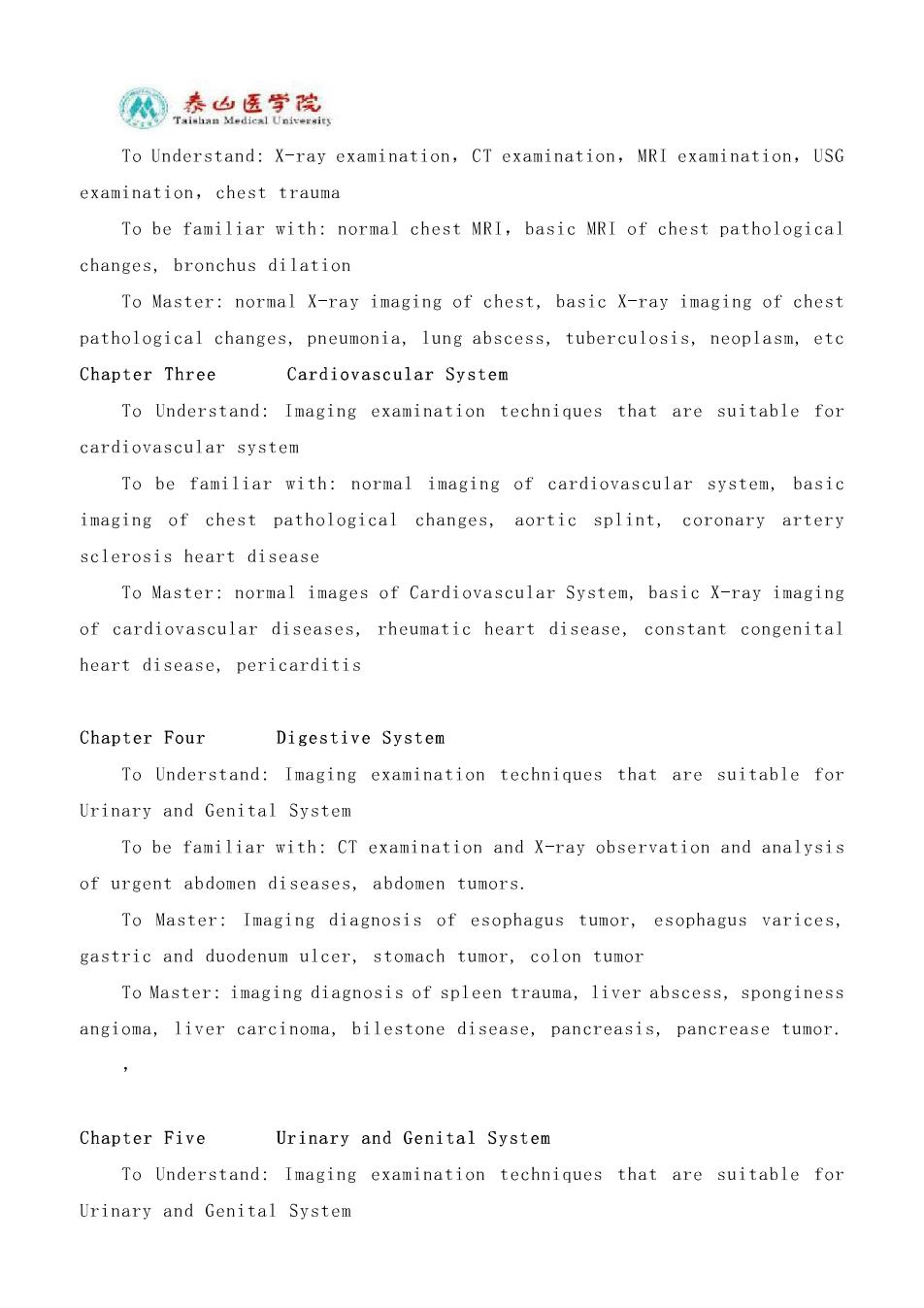
从春也医学汽 To Understand:X-ray examination,CT examination,MRI examination,USG examination,chest trauma To be familiar with:normal chest MRI,basic MRI of chest pathological changes,bronchus dilation To Master:normal X-ray imaging of chest,basic X-ray imaging of chest pathological changes,pneumonia,lung abscess,tuberculosis,neoplasm,etc Chapter Three Cardiovascular System To Understand:Imaging examination techniques that are suitable for cardiovascular system To be familiar with:normal imaging of cardiovascular system,basic imaging of chest pathological changes,aortic splint,coronary artery sclerosis heart disease To Master:normal images of Cardiovascular System,basic X-ray imaging of cardiovascular diseases,rheumatic heart disease,constant congenital heart disease,pericarditis Chapter Four Digestive System To Understand:Imaging examination techniques that are suitable for Urinary and Genital System To be familiar with:CT examination and X-ray observation and analysis of urgent abdomen diseases,abdomen tumors. To Master:Imaging diagnosis of esophagus tumor,esophagus varices, gastric and duodenum ulcer,stomach tumor,colon tumor To Master:imaging diagnosis of spleen trauma,liver abscess,sponginess angioma,liver carcinoma,bilestone disease,pancreasis,pancrease tumor. Chapter Five Urinary and Genital System To Understand:Imaging examination techniques that are suitable for Urinary and Genital System
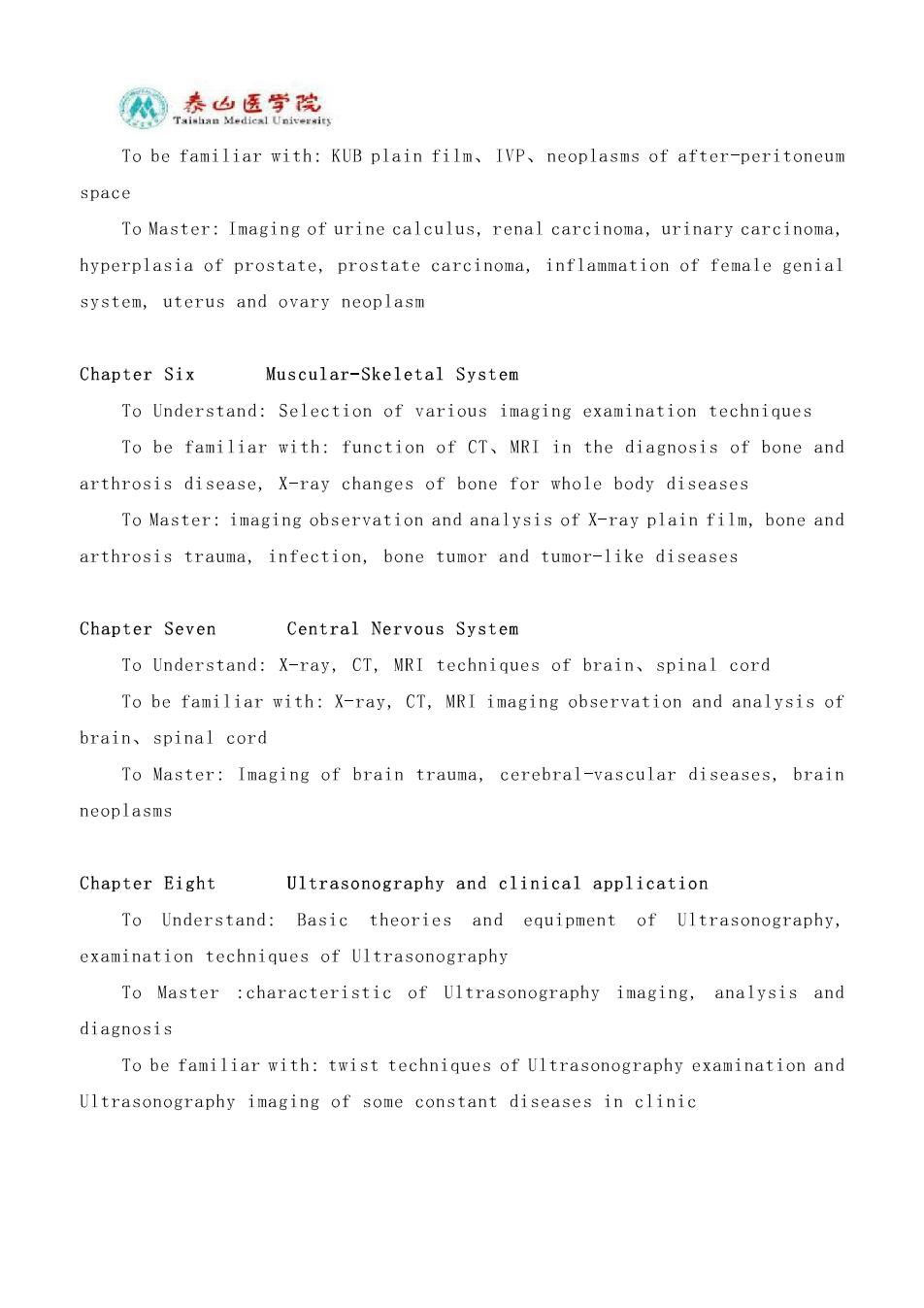
从泰医学院 To be familiar with:KUB plain film,IVP,neoplasms of after-peritoneum space To Master:Imaging of urine calculus,renal carcinoma,urinary carcinoma, hyperplasia of prostate,prostate carcinoma,inflammation of female genial system,uterus and ovary neoplasm Chapter Six Muscular-Skeletal System To Understand:Selection of various imaging examination techniques To be familiar with:function of CT,MRI in the diagnosis of bone and arthrosis disease,X-ray changes of bone for whole body diseases To Master:imaging observation and analysis of X-ray plain film,bone and arthrosis trauma,infection,bone tumor and tumor-like diseases Chapter Seven Central Nervous System To Understand:X-ray,CT,MRI techniques of brain,spinal cord To be familiar with:X-ray,CT,MRI imaging observation and analysis of brain、spinal cord To Master:Imaging of brain trauma,cerebral-vascular diseases,brain neoplasms Chapter Eight Ultrasonography and clinical application To Understand:Basic theories and equipment of Ultrasonography, examination techniques of Ultrasonography To Master characteristic of Ultrasonography imaging,analysis and diagnosis To be familiar with:twist techniques of Ultrasonography examination and Ultrasonography imaging of some constant diseases in clinic
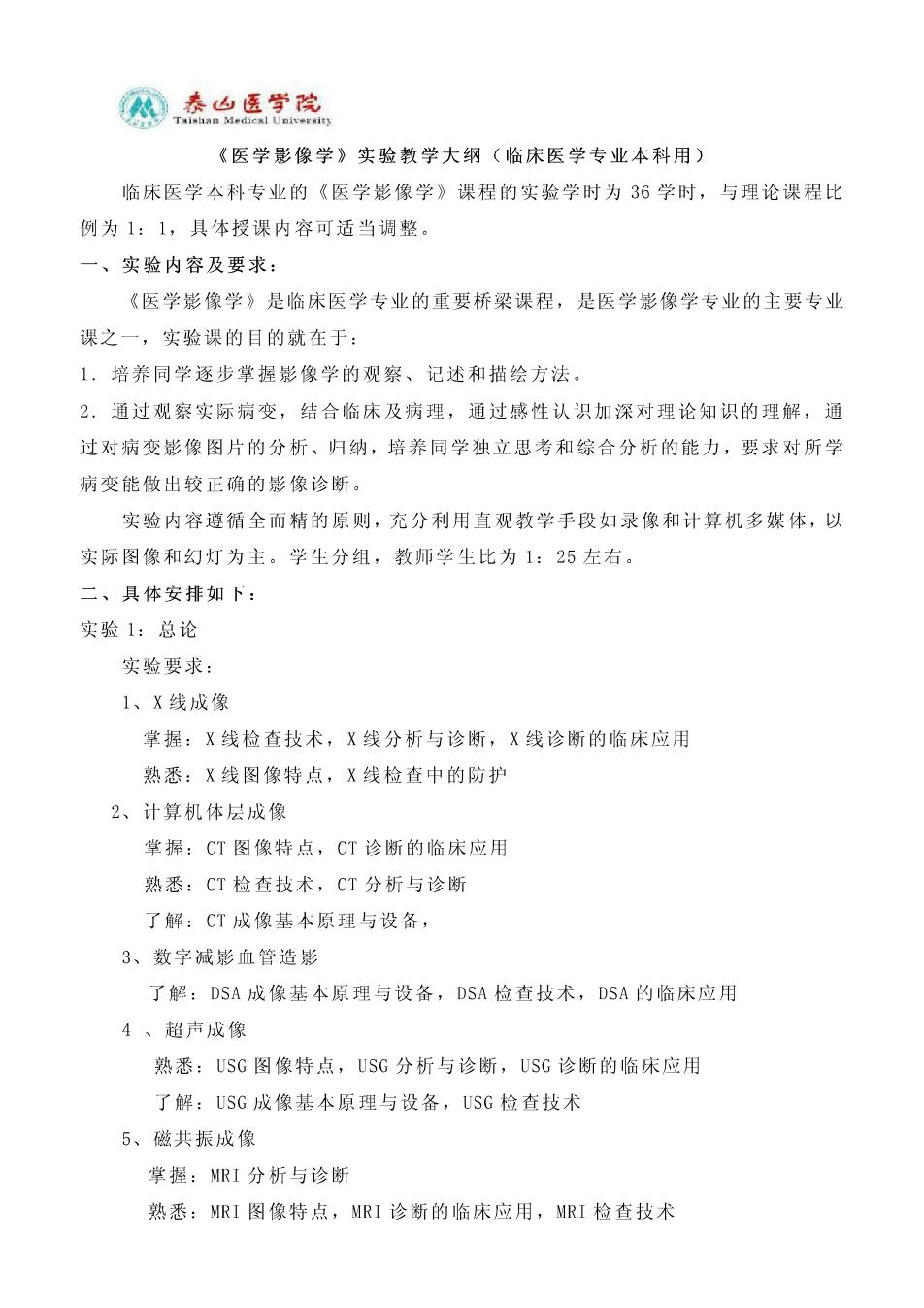
从表也医学院 《医学影像学》实验教学大纲(临床医学专业本科用) 临床医学本科专业的《医学影像学》课程的实验学时为36学时,与理论课程比 例为1:1,具体授课内容可适当调整 一、实验内容及要求: 《医学彪像学》是临床医学专业的重要桥梁课程,是医学影像学专业的主要专业 课之一,实验课的目的就在于: 1,培养同学逐步掌握影像学的观察、记述和描绘方法。 2.通过观察实际病变,结合临床及病理,通过感性认识加深对理论知识的理解,通 过对病变能像图片的分析、归纳,培养同学独立思考和综合分析的能力,要求对所学 病变能做出较正确的影像诊断。 实验内容遵循全而精的原则,充分利用直观教学手段如录像和计算机多媒体,以 实际图像和幻灯为主。学生分组,教师学生比为1:25左右。 二、具体安排如下 实验1:总论 实验要求: 1、X线成像 草握:X线检查技术,X线分析与诊断,X线诊断的临床应用 熟悉:X线图像特点,X线检查中的防护 2、计算机体层成像 掌握:CT图像特点,CT诊断的临床应用 熟悉:CT检查技术,CT分析与诊断 了解:CT成像基本原理与设备, 3、数字减影血管造影 了解:DSA成像基本原理与设备,DSA检查技术,DSA的临床应用 4、超声成像 熟悉:USG图像特点,USG分析与诊断,USG诊断的临床应用 了解:USG成像基本原理与设备,USG检查技术 5、磁共振成像 掌握:MRI分析与诊断 熟悉:MRI图像特点,MRI诊断的临床应用,NRI检查技术

瓜,泰医学院 了解:MRI成像基本原理与设备 6、不同成像诊断的综合应用 熟悉:不同成像诊断的综合应用 7、数字化X线成像、图像存档与传输系统、信息放射科学 了解:数字化X线成像,图像存档与传输系统,信息放射学 实验内容: 1、X线检查技术,X线分析与诊断,X线诊断的临床应用 2、CT检查技术,CT分析与诊断、CT图像特点,CT诊断的临床应用 3、DSA成像基本原理与设备,DSA检查技术,DSA的临床应用 4、USG图像特点,USG分析与诊断,USG诊断的临床应用 5、MRI图像特点,MRI诊断的临床应用,MRI检查技术 (观看卫生部录像带) 实验时数:2学时 实验2:呼吸系统①胸部正常老像及基本病变 实验要求: 1、学握:正常胸部的X线、CT解剖 2、学握:纵隔正常X线、CT、MR解剖和纵隔分区 3、熟悉:横丽、胸膜的X线、CT解剂 4、全面掌握支气管阻塞、渗出、增殖、纤维化、肿块、空洞和胸腔疾病的病理基础 和X线、CT表现 5、鉴别肺内的基本病变的X线特点,特别是肿块、空洞和栗粒影的鉴别 实验内容: (一)胸廓: 1、软组织胸廊:胸锁乳突肌、锁骨上皮肤皱褶、胸大肌、女性乳头及乳房 2、骨性胸廓:肋骨、肋软骨钙化:肩胛骨、锁骨、胸骨及胸椎:各种肋骨先天 性变异 (二)肺野和肺门 1、肺野:肺野的划分:特殊的肺区一一肺尖区和锁骨下区:肺段、肺叶和肺纹理 2、肺门:肺门是肺动脉、静脉、支气管和淋巴、神经组织的总和投影:左右肺门

泰医学院 的部位;右侧肺门角和肺门点 (三)纵隔: 1、正位纵隔的X线、CT、MR影像,左右纵隔缘的组成 2、恻位九分法,纵隔的分区和各区的X线解剖 3、纵隔的生理性变化 (四)支气管的基本病变: 1、阻塞性肺气肿:小叶性、间质性和大泡性肺气肿的X线表现 2、阻塞性肺不张:各型肺不张的X线表现,主要掌握各叶肺不张、下三角征、 大雅征等 3、阻塞性肺炎:各叶阻塞型肺炎的X线表现 (五)肺部基本病变: 1、渗出与实变:渗出与实变的X线表现,支气管气像:运用轮廓征确定病变的叶 段 2、增殖:增殖性腺泡结节影的X线表现 3、纤维化:弥漫性和局限性纤维化的X线表现 4、钙化:各型钙化的X线表现 5、肿块:肿块的X线表现 6、空洞与空腔:空洞与空腔的X线、CT鉴别:三种空洞的X线、CT表现 7、间质性病变:粗网状结节间质纤维化和细网状结节间质纤维化的X线表现 (六)肺门的改变: 1、肺门影增大:肺门血管扩张、淋巴结肿大、支气管肿瘤 2、肺门影缩小:肺门血管缩小 3、肺门移位:肺不张、胸腔积液、气胸 实验时数:2学时 实验3:呼吸系统②肺部感染性疾病和肺结核 实验要求: 1、熟悉:大叶性肺炎各期的X线、CT表现及病理基础
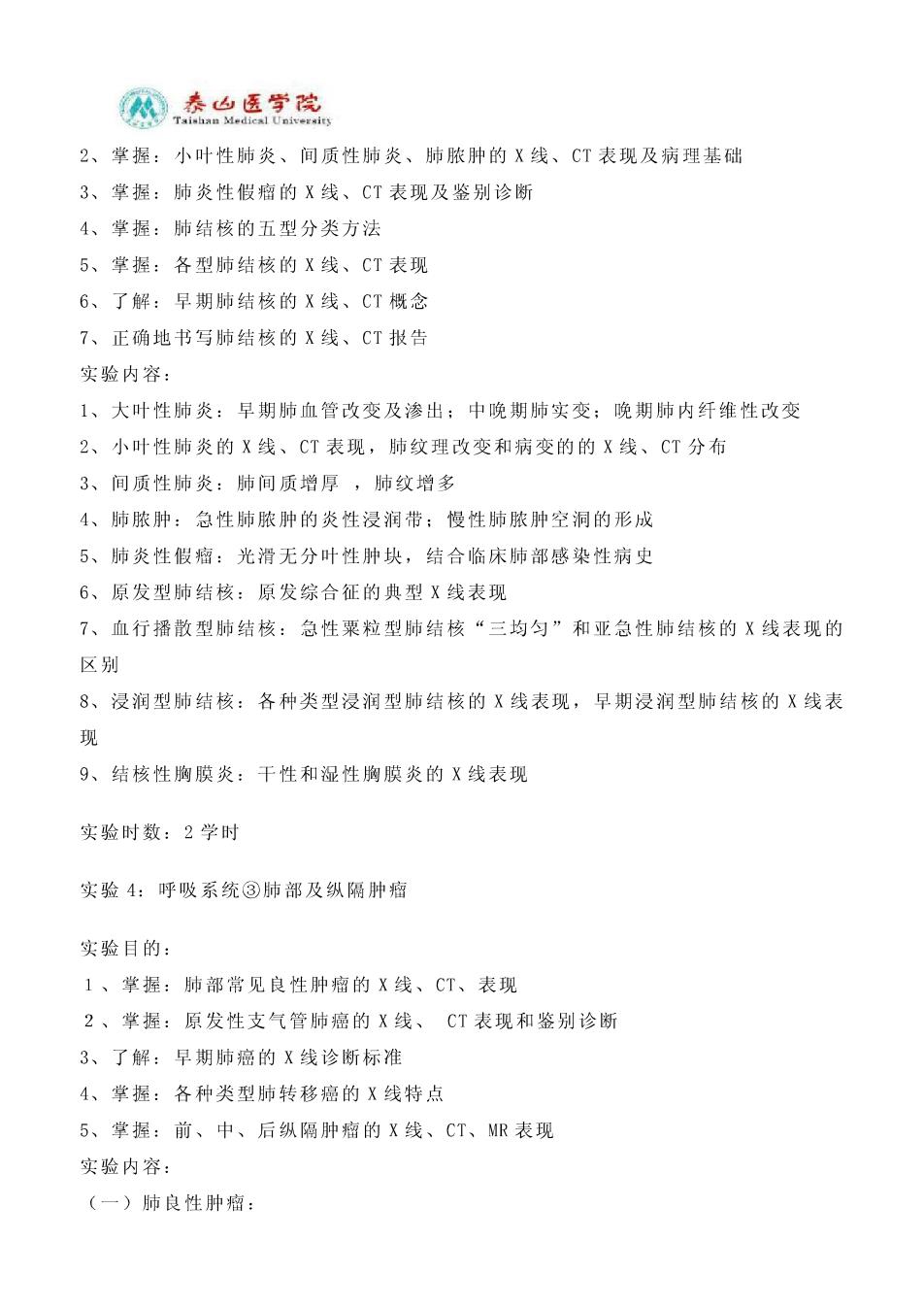
从泰医学院 2、掌握:小叶性肺炎、间质性肺炎、肺脓肿的X线、CT表现及病理基础 3、掌握:肺炎性假瘤的X线、CT表现及鉴别诊断 4、掌握:肺结核的五型分类方法 5、掌握:各型肺结核的X线、CT表现 6、了解:早期肺结核的X线、CT概念 7、正确地书写肺结核的X线、CT报告 实验内容: 1、大叶性肺炎:早期肺血管改变及渗出:中晚期肺实变:晚期肺内纤维性改变 2、小叶性肺炎的X线、CT表现,肺纹理改变和病变的的X线、CT分布 3、间质性肺炎:肺间质增厚,肺纹增多 4、肺脓肿:急性肺脓肿的炎性浸润带;慢性肺脓肿空洞的形成 5、肺炎性假瘤:光滑无分叶性肿块,结合临床肺部感染性病史 6、原发型肺结核:原发综合征的典型X线表现 7、血行播散型肺结核:急性粟粒型肺结核“三均匀”和亚急性肺结核的X线表现的 区别 8、浸润型肺结核:各种类型浸润型肺结核的X线表现,早期浸润型肺结核的X线表 现 9、结核性胸膜炎:干性和湿性胸膜炎的X线表现 实验时数:2学时 实验4:呼吸系统③肺部及纵隔肿瘤 实验目的: 1、掌握:肺部常见良性肿瘤的X线、CT、表现 2、掌握:原发性支气管肺癌的X线、CT表现和鉴别诊断 3、了解:早期肺癌的X线诊断标准 4、掌握:各种类型肺转移癌的X线特点 5、掌握:前、中、后纵隔肿瘤的X线、CT、MR表现 实验内容: (一)肺良性肿瘤